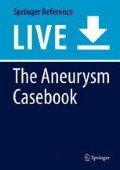Abstract
A ruptured wide necked giant aneurysm (28 mm diameter fundus) of the internal carotid artery (ICA) with incorporation of the posterior communicating artery (PcomA) was initially treated by subtotal endovascular coil occlusion with 3D Hydrocoils (HydroFrame 18, MicroVention) and bare platinum coils to prevent recurrent subarachnoid hemorrhage (SAH). The initial clinical status of the patient was Hunt and Hess V with a Fisher grade of III. The patient had no complications and recovered completely. Two months after the first intervention, the wide necked remnant of the aneurysm was covered with a single Derivo flow diverter (Acandis) by reconstruction of a relatively long ICA segment, while the fetal origin of the PCA, originating from the neck, had to remain patent. After flow diverter placement, we saw thrombosis of the aneurysm including the PCA and the anterior cerebral artery (ACA), which completely resolved after the IA application of eptifibatide (Integrilin, GalxoSmithKline) and no ischemic complication occurred. Two months later the patient presented with nausea, blurred vision, and a transient hearing impairment. MRI showed peri-aneurysmal edema of the right temporal lobe, which could be either a complication of the implanted Hydrocoils or due to complete thrombosis of the aneurysm, confirmed by a subsequent follow-up angiography. Under treatment with steroids, the neurological symptoms resolved completely within three days. This case illustrates the benefit of a staged approach in a ruptured giant aneurysm with a complex anatomy. Initial coil packing not only stabilized the rupture site of the aneurysm but also supported a stable positioning of the microcatheter in the distal ICA to deploy the Derivo flow diverter. Flow diversion has the potential of complete aneurysm obliteration in aneurysms with an arterial branch arising from the aneurysm neck. The combination of partial coil occlusion together with extrasaccular flow diversion without compromise of an adjacent side branch is the main topic of this report.
References
Brinjikji W, Piano M, Fang S, Pero G, Kallmes DF, Quilici L, Valvassori L, Lozupone E, Cloft HJ, Boccardi E, Lanzino G. Treatment of ruptured complex and large/giant ruptured cerebral aneurysms by acute coiling followed by staged flow diversion. J Neurosurg. 2016;125(1):120–7. https://doi.org/10.3171/2015.6.JNS151038.
Fanning NF, Willinsky RA, ter Brugge KG. Wall enhancement, edema, and hydrocephalus after endovascular coil occlusion of intradural cerebral aneurysms. J Neurosurg. 2008;108(6):1074–86. https://doi.org/10.3171/JNS/2008/108/6/1074.
Gaba RC, Ansari SA, Roy SS, Marden FA, Viana MA, Malisch TW. Embolization of intracranial aneurysms with hydrogel-coated coils versus inert platinum coils: effects on packing density, coil length and quantity, procedure performance, cost, length of hospital stay, and durability of therapy. Stroke. 2006;37(6):1443–50.
Moshayedi H, Omofoye OA, Yap E, Oyekunle TO, Sasaki-Adams DM, Solander SY. Factors affecting the obliteration rate of intracranial aneurysms treated with a single Pipeline Embolization Device. World Neurosurg. 2017;104:205–12. https://doi.org/10.1016/j.wneu.2017.04.111.
Author information
Authors and Affiliations
Corresponding author
Editor information
Editors and Affiliations
Rights and permissions
Copyright information
© 2018 Springer International Publishing AG, part of Springer Nature
About this entry
Cite this entry
Kirsch, M. (2018). Posterior Communicating Artery Aneurysm: Giant Aneurysm of the Internal Carotid Artery, Acute SAH, Ruptured Wide Neck Aneurysm, Incorporation of the Fetal Origin of the Posterior Cerebral Artery; Coil Occlusion, Secondary Treatment of the Neck Remnant with a Single Derivo Flow Diverter, Intra-procedural Thrombosis, Intra-arterial Eptifibatide Infusion, Good Clinical Outcome. In: Henkes, H., Lylyk, P., Ganslandt, O. (eds) The Aneurysm Casebook. Springer, Cham. https://doi.org/10.1007/978-3-319-70267-4_11-2
Download citation
DOI: https://doi.org/10.1007/978-3-319-70267-4_11-2
Received:
Accepted:
Published:
Publisher Name: Springer, Cham
Print ISBN: 978-3-319-70267-4
Online ISBN: 978-3-319-70267-4
eBook Packages: Springer Reference MedicineReference Module Medicine
Publish with us
Chapter history
-
Latest
Posterior Communicating Artery Aneurysm: Giant Aneurysm of the Internal Carotid Artery, Acute SAH, Ruptured Wide Neck Aneurysm, Incorporation of the Fetal Origin of the Posterior Cerebral Artery; Coil Occlusion, Secondary Treatment of the Neck Remnant with a Single Derivo Flow Diverter, Intra-procedural Thrombosis, Intra-arterial Eptifibatide Infusion, Good Clinical Outcome- Published:
- 07 May 2018
DOI: https://doi.org/10.1007/978-3-319-70267-4_11-2
-
Original
Posterior Communicating Artery Aneurysm: Giant Aneurysm of the Internal Carotid Artery, Acute SAH, Ruptured Wide Neck Aneurysm, Incorporation of the Fetal Origin of the Posterior Cerebral Artery; Coil Occlusion, Secondary Treatment of the Neck Remnant with a Single Derivo Flow Diverter, Intra-procedural Thrombosis, Intra-arterial Eptifibatide Infusion, Good Clinical Outcome- Published:
- 14 February 2018
DOI: https://doi.org/10.1007/978-3-319-70267-4_11-1

